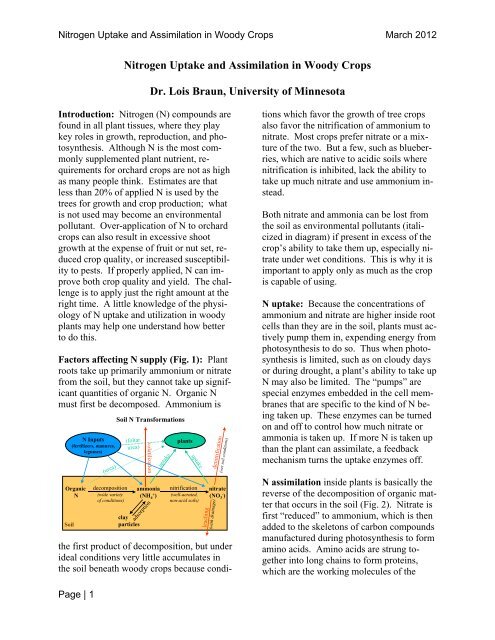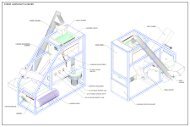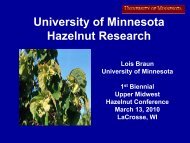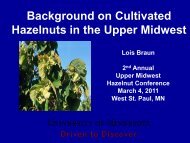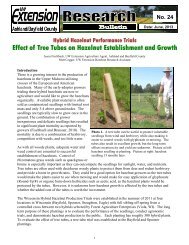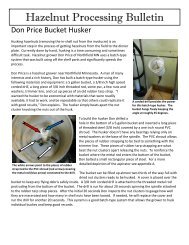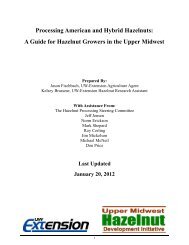Nitrogen Uptake and Assimilation - Upper Midwest Hazelnut ...
Nitrogen Uptake and Assimilation - Upper Midwest Hazelnut ...
Nitrogen Uptake and Assimilation - Upper Midwest Hazelnut ...
Create successful ePaper yourself
Turn your PDF publications into a flip-book with our unique Google optimized e-Paper software.
<strong>Nitrogen</strong> <strong>Uptake</strong> <strong>and</strong> <strong>Assimilation</strong> in Woody Crops March 2012<br />
<strong>Nitrogen</strong> <strong>Uptake</strong> <strong>and</strong> <strong>Assimilation</strong> in Woody Crops<br />
Dr. Lois Braun, University of Minnesota<br />
Introduction: <strong>Nitrogen</strong> (N) compounds are<br />
found in all plant tissues, where they play<br />
key roles in growth, reproduction, <strong>and</strong> photosynthesis.<br />
Although N is the most commonly<br />
supplemented plant nutrient, requirements<br />
for orchard crops are not as high<br />
as many people think. Estimates are that<br />
less than 20% of applied N is used by the<br />
trees for growth <strong>and</strong> crop production; what<br />
is not used may become an environmental<br />
pollutant. Over-application of N to orchard<br />
crops can also result in excessive shoot<br />
growth at the expense of fruit or nut set, reduced<br />
crop quality, or increased susceptibility<br />
to pests. If properly applied, N can improve<br />
both crop quality <strong>and</strong> yield. The challenge<br />
is to apply just the right amount at the<br />
right time. A little knowledge of the physiology<br />
of N uptake <strong>and</strong> utilization in woody<br />
plants may help one underst<strong>and</strong> how better<br />
to do this.<br />
Factors affecting N supply (Fig. 1): Plant<br />
roots take up primarily ammonium or nitrate<br />
from the soil, but they cannot take up significant<br />
quantities of organic N. Organic N<br />
must first be decomposed. Ammonium is<br />
Soil<br />
N Inputs<br />
(fertilizers, manures,<br />
legumes)<br />
Organic<br />
N<br />
(urea)<br />
decomposition<br />
(wide variety<br />
of conditions)<br />
Soil N Transformations<br />
(foliar<br />
urea)<br />
clay<br />
particles<br />
ammonia<br />
(NH 4+ )<br />
adsorption<br />
volatilization<br />
uptake<br />
plants<br />
uptake<br />
nitrification<br />
(well-aerated,<br />
non-acid soils)<br />
leaching<br />
denitrification<br />
(wet soil conditions)<br />
nitrate<br />
(NO 3- )<br />
(with drainage)<br />
the first product of decomposition, but under<br />
ideal conditions very little accumulates in<br />
the soil beneath woody crops because conditions<br />
which favor the growth of tree crops<br />
also favor the nitrification of ammonium to<br />
nitrate. Most crops prefer nitrate or a mixture<br />
of the two. But a few, such as blueberries,<br />
which are native to acidic soils where<br />
nitrification is inhibited, lack the ability to<br />
take up much nitrate <strong>and</strong> use ammonium instead.<br />
Both nitrate <strong>and</strong> ammonia can be lost from<br />
the soil as environmental pollutants (italicized<br />
in diagram) if present in excess of the<br />
crop’s ability to take them up, especially nitrate<br />
under wet conditions. This is why it is<br />
important to apply only as much as the crop<br />
is capable of using.<br />
N uptake: Because the concentrations of<br />
ammonium <strong>and</strong> nitrate are higher inside root<br />
cells than they are in the soil, plants must actively<br />
pump them in, expending energy from<br />
photosynthesis to do so. Thus when photosynthesis<br />
is limited, such as on cloudy days<br />
or during drought, a plant’s ability to take up<br />
N may also be limited. The “pumps” are<br />
special enzymes embedded in the cell membranes<br />
that are specific to the kind of N being<br />
taken up. These enzymes can be turned<br />
on <strong>and</strong> off to control how much nitrate or<br />
ammonia is taken up. If more N is taken up<br />
than the plant can assimilate, a feedback<br />
mechanism turns the uptake enzymes off.<br />
N assimilation inside plants is basically the<br />
reverse of the decomposition of organic matter<br />
that occurs in the soil (Fig. 2). Nitrate is<br />
first “reduced” to ammonium, which is then<br />
added to the skeletons of carbon compounds<br />
manufactured during photosynthesis to form<br />
amino acids. Amino acids are strung together<br />
into long chains to form proteins,<br />
which are the working molecules of the<br />
Page | 1
xylem<br />
xylem<br />
<strong>Nitrogen</strong> <strong>Uptake</strong> <strong>and</strong> <strong>Assimilation</strong> in Woody Crops March 2012<br />
plant. Like in N uptake, each of these steps<br />
requires energy from photosynthesis, but N<br />
assimilation has the additional requirement<br />
of carbon skeletons (carbohydrates) from<br />
photosynthesis. Thus N assimilation is doubly<br />
dependent on conditions that favor photosynthesis:<br />
adequate light, heat, moisture,<br />
<strong>and</strong> green leaves.<br />
nitrate<br />
proteins<br />
ammonia<br />
Sites of N <strong>Assimilation</strong><br />
<strong>and</strong> N Distribution<br />
amino<br />
acids<br />
amino<br />
acids<br />
developing leaves<br />
amino<br />
proteins<br />
acids<br />
phloem<br />
storage<br />
in bark<br />
proteins<br />
mature<br />
leaves<br />
nitrate ammonia amino acids proteins<br />
N distribution <strong>and</strong> allocation (Fig. 2): N<br />
taken up by the roots is transported to the<br />
leaves in the xylem sap (solid lines), either<br />
as nitrate or as amino acids. After that N is<br />
redistributed in the phloem (dashed lines) as<br />
amino acids, according to dem<strong>and</strong>, from<br />
“source to sink”. Because N is a component<br />
of chlorophyll <strong>and</strong> other vital enzymes of<br />
photosynthesis, the leaves are very strong<br />
“sinks” for N. <strong>Nitrogen</strong> is also important for<br />
growth, so rapidly developing tissues, such<br />
as buds, new leaves, <strong>and</strong> developing fruits<br />
<strong>and</strong> nuts, are also important sinks.<br />
In order to make the best use of their N supply,<br />
plants recycle it from tissues where it is<br />
no longer needed to ones where it is needed.<br />
For example, after growth is complete in a<br />
new leaf, some of the proteins in it may be<br />
broken down into amino acids <strong>and</strong> transported<br />
to younger leaves, or to a developing<br />
fruit or seed. Likewise, if a leaf becomes<br />
shaded, so that it no longer photosynthesizes<br />
efficiently, its N may be translocated to another<br />
leaf that is in the full sun.<br />
In the fall, trees withdraw most of the N<br />
from their leaves before leaf-fall <strong>and</strong><br />
transport it in the phloem to winter storage<br />
sites either just beneath the bark or in the<br />
roots. In the spring this stored N can be remobilized<br />
for bud break much more efficiently<br />
than N from the soil because it is already<br />
present as either amino acids or simple<br />
proteins, sparing the energy expenditure<br />
for uptake or assimilation. This is fortunate<br />
because until the new leaves are functional<br />
they cannot supply the energy that would<br />
otherwise be needed. Moreover, bud break<br />
often occurs at a time when root uptake <strong>and</strong><br />
soil N availability are poor due to cold soils.<br />
Early-season tree growth depends almost entirely<br />
on stored N, with N contributions from<br />
spring-applied fertilizer becoming important<br />
only later in the season. Because flowering<br />
<strong>and</strong> fruit set occur early, spring-applied N<br />
fertilizer might not affect yield until a whole<br />
season after application. Thus the objective<br />
of fertilization should be to build reserves<br />
for flowering <strong>and</strong> early shoot growth in future<br />
years. <strong>Nitrogen</strong> applied after harvest<br />
may be taken up efficiently as long as leaves<br />
have not yet senesced. It goes directly into<br />
storage for the next season’s growth.<br />
Two key concepts <strong>and</strong> implications:<br />
1) Trees are very efficient at recycling N.<br />
The older they get, the more N they are able<br />
to store from one season to the next <strong>and</strong> the<br />
less important new uptake becomes. Thus<br />
fertilization of mature trees needs only to<br />
replace the N removed by harvest <strong>and</strong> pruning.<br />
Young trees, which are still building<br />
their reserves, need more N relative to their<br />
size, but, with fewer roots, are more limited<br />
in their capacity to take it up <strong>and</strong> use it.<br />
2) N uptake <strong>and</strong> assimilation require energy<br />
from photosynthesis. The development of<br />
photosynthetic capacity by young trees must<br />
be balanced with N uptake, or excess N may<br />
be lost to the environment. Thus young<br />
Page | 2
<strong>Nitrogen</strong> <strong>Uptake</strong> <strong>and</strong> <strong>Assimilation</strong> in Woody Crops March 2012<br />
trees should be fertilized in proportion to<br />
their size or age. <strong>Nitrogen</strong> fertilizer applied<br />
at times of year when photosynthesis is low,<br />
such as winter or during mid-summer<br />
drought, may not be taken up <strong>and</strong> may also<br />
be lost.<br />
Recommended References:<br />
Sanchez, E.E., H. Khemira, D. Sugar, <strong>and</strong> T.L.<br />
Righetti. 1995. <strong>Nitrogen</strong> management in orchards.<br />
p. 327 – 380. In P.E. Bacon (ed.) <strong>Nitrogen</strong> fertilization<br />
in the environment. Marcel Decker, New York.<br />
Titus, J.S. <strong>and</strong> S.M. Kang. 1982. <strong>Nitrogen</strong> metabolism,<br />
translocation, <strong>and</strong> recycling in apple trees.<br />
Hort. Reviews 4:204-246.<br />
Important concepts not covered:<br />
1. Urea: Urea is a very simple organic<br />
compound that can be taken up in small<br />
quantities by some roots <strong>and</strong> also by leaves.<br />
Foliar urea sprays may be very efficient because<br />
there are no N leaching losses <strong>and</strong> because<br />
urea assimilation can bypass nitrate<br />
reduction, thereby saving the plant energy.<br />
2. Competition between ions for uptake:<br />
N uptake is influenced by other nutrients in<br />
the soil. Ammonium, which is positively<br />
charged, may inhibit the uptake of other positively<br />
charged nutrients, such as calcium or<br />
magnesium. Nitrate, which is negatively<br />
charged, may compete with other negatively<br />
charged nutrients, such as phosphate or sulfur.<br />
This is not common in nature, but it can<br />
be a significant problem if large quantities<br />
of unbalanced fertilizers are applied, especially<br />
in containerized plants.<br />
3. The effects of NH 4 + vs NO 3 - on soil pH<br />
Plants roots exude either H + or OH - to balance<br />
the charges of the N ion taken up,<br />
which can have profound effects on soil pH.<br />
4. Sites of assimilation<br />
Conversion of nitrate to amino acids occurs<br />
in the roots in most fruit trees, but nitrate<br />
may be translocated to leaves if nitrate supply<br />
is high, such as in the case of very high<br />
N fertilization.<br />
5. Root:shoot ratios<br />
N may also be sent to grow more roots.<br />
This is especially likely if the N supply in<br />
the soil is low, because additional roots can<br />
explore the soil for previously unexploited<br />
N. This is why plants in N-deficient soils<br />
tend to grow proportionately larger root systems<br />
whereas plants well fertilized with N<br />
grow larger tops. This is another example of<br />
how N allocation is determined by dem<strong>and</strong>.<br />
Although we may think that trees with larger<br />
tops would be more productive, they may<br />
have other problems, such as susceptibility<br />
to drought <strong>and</strong> weak anchorage. Balanced<br />
root to shoot growth is important.<br />
6. Effect of excess N on fruit or nut quality:<br />
Fruit set is enhanced by high N. With<br />
excessive N more fruit may be set than the<br />
plant is able to support to photosynthetic ally:<br />
the number of developing fruit supported<br />
by each spur may be too high for the<br />
number of leaves supplying them. This results<br />
in smaller fruit. In nuts this results in<br />
poorly filled out kernels. In fruit there may<br />
be additional metabolic problems caused by<br />
imbalances between N <strong>and</strong> other nutrients,<br />
especially Ca 2+ , leading to poor firmness<br />
<strong>and</strong> susceptibility to diseases.<br />
7. Interpretation of Leaf N Concentrations<br />
for Figuring N application rates.<br />
Growers wishing to fertilize responsibly are<br />
often advised to base their N rates on leaf N<br />
concentrations, but leaf N is not easy to interpret:<br />
high N supply may stimulate<br />
growth, which may lower leaf N concentration<br />
by dilution, <strong>and</strong> vice versa. Leaf analysis<br />
is, however, still useful if considered together<br />
with plant vigor. If shoot growth or<br />
yield are high <strong>and</strong> leaf N is also high, that is<br />
a sign of past over-fertilization, whereas if<br />
both are low fertilization should be in-<br />
Page | 3
<strong>Nitrogen</strong> <strong>Uptake</strong> <strong>and</strong> <strong>Assimilation</strong> in Woody Crops March 2012<br />
creased. If shoot growth or yield are low but<br />
leaf N is high, then there is probably a deficiency<br />
of some other nutrient or growth requirement.<br />
If shoot growth or yield are high<br />
but leaf N is low, then fertilization is probably<br />
optimal.<br />
Page | 4


